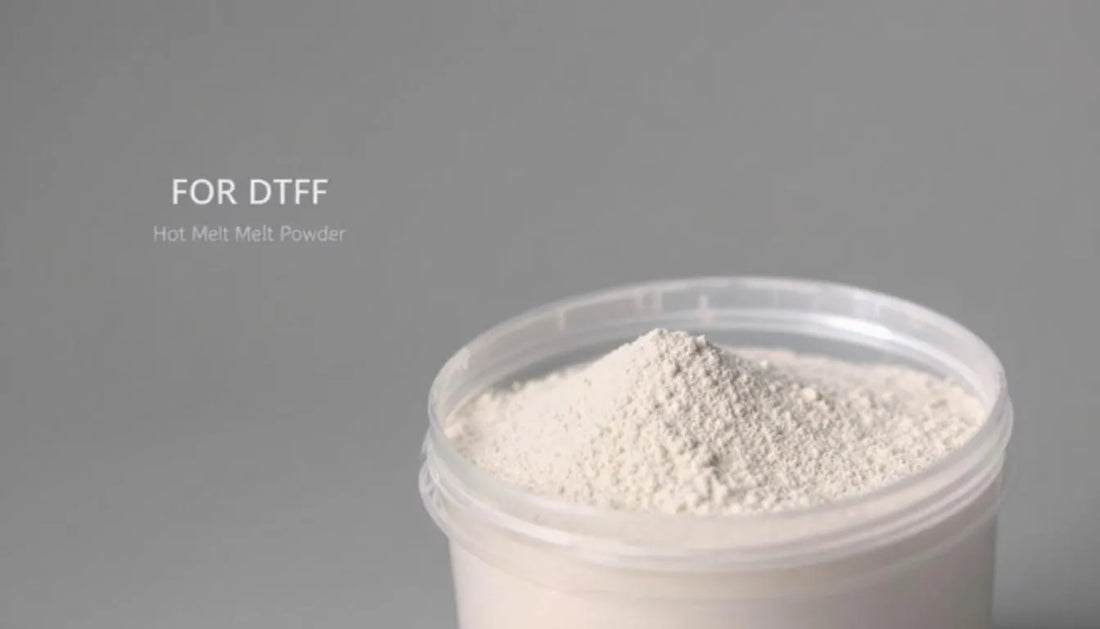
Hot Melt Powder for DTF: Types, Melt Points, and Fabric Compatibility
DTF hot-melt powder is the adhesive engine behind every durable transfer. Choosing the right chemistry, melt point, and mesh size—and pairing them with the right fabric and press window—determines hand feel, stretch, and wash fastness. Use this guide to pick and dial your powder for reliable, premium results.
Powder Chemistries & Melt Behavior
Most DTF powders are thermoplastic resins that soften, flow, and re-solidify to bond ink to fabric. The three common families are:
| Chemistry | Typical Melt/Flow Range* | Strengths | Trade-offs | Best Use |
|---|---|---|---|---|
| TPU (Thermoplastic Polyurethane) | ≈ 110–130 °C | Soft, elastic hand; great stretch & recovery; strong bonding to cotton & blends | Can feel rubbery if over-coated; slightly higher cost | Tees/hoodies, stretch garments, general purpose |
| Co-PES (Copolyester) | ≈ 100–120 °C | Firm hand; good chemical/heat resistance; crisp edge integrity | Less stretch than TPU; can feel stiffer on light tees | Polyester teamwear, workwear, signage textiles |
| Co-PA (Copolyamide) | ≈ 90–110 °C | Good adhesion to nylons & tricky synthetics; lower activation temperature | Can block/soften at low storage temps; may feel firmer | Nylon shells, windbreakers, bags, technical fabrics |
*Ranges vary by brand/formulation. Always follow your powder’s datasheet and verify with an IR thermometer.
Mesh Size & Coating Weight
- 80–120 mesh (fine): Clean edges and softer hand; best for detail and thin graphics.
- 60–80 mesh (medium): General purpose; balances bite and feel.
- 45–60 mesh (coarse): More “tooth” for heavy cottons/texture; can feel grainy.
- Target grams/print: Chest design often lands at 6–10 g. Evenness beats volume—excess powder increases stiffness and risk of cracking.
Fabric Compatibility (Pick the Powder for the Job)
| Fabric | Recommended Powder | Press Window (Hot-Peel Films)** | Notes |
|---|---|---|---|
| Cotton (ring-spun, carded) | TPU (fine/med mesh) | 150–165 °C, 10–15 s, medium pressure | Softer hand with fine mesh; finish press 5–10 s |
| Poly/Cotton blends | TPU or Co-PES | 150–160 °C, 10–15 s | Watch dye migration on vivid polys—lower temp if needed |
| 100% Polyester (teamwear) | Co-PES (fine/med mesh) | 145–155 °C, 12–15 s | Lower temp to reduce dye bleed; quick, smooth peel |
| Nylon (shells/windbreakers) | Co-PA (fine mesh) | 140–150 °C, 12–15 s | Pre-press 2–3 s to flash off moisture; firm finish burnish |
| Stretch (spandex/lycra blends) | TPU (fine mesh) | 145–155 °C, 12–15 s | TPU maintains stretch; avoid over-powdering |
| Fleece/terry & textured knits | TPU (med mesh) | 155–165 °C, 12–15 s | Use foam pad to even pressure over seams/texture |
**Always confirm with your film manufacturer; use an IR thermometer to verify platen temperature.
Curing the Powder (On Film) vs. Pressing (On Garment)
Powder Cure (before pressing)
- Goal: Flow granules into a continuous adhesive with a satin “orange-peel” look.
- Starting point (inline ovens): ~110–130 °C film surface for 2–6 min depending on film/powder.
- Under-cure signs: Chalky crystals, powder rub-off, weak wash.
- Over-cure signs: Yellowing, glassy/brittle feel, stiff hand.
Heat Press (transfer to fabric)
- Baseline: 150–165 °C, 10–15 s, medium pressure for hot-peel films.
- Adjust for synthetics: Drop 5–10 °C and extend 2–3 s to control dye migration and heat sensitivity.
- Finish press: 5–10 s with parchment/Teflon after peel to improve embedding and wash fastness.
Edge Quality, Hand Feel & Opacity (How Powder Interacts)
- White underbase strategy: Add a slight choke (inward offset) so powder doesn’t cling outside color. Use the lowest white that keeps colors vibrant on darks.
- Mesh vs. detail: Finer mesh keeps micro text and sharp corners clean; coarse meshes tend to “sugar” edges.
- Coating weight: Heavier coat does not equal stronger bond—aim for even, thin coverage that fully wets and flows.
Storage, Handling & Reuse
- Dry & sealed: Powders are hygroscopic—store in sealed containers with desiccant. Moist powder clumps and resists flow.
- Temperature: Cool, stable room conditions. Avoid direct heat/sunlight; don’t store on warm machinery.
- Recycling excess: Only recycle clean, dry powder from recovery trays. Discard if contaminated with fibers/ink dust.
- Sifting: If your workflow allows, sieve recycled powder to maintain consistent mesh size.
Common Problems & Fast Fixes
| Symptom | Likely Cause | Fix |
|---|---|---|
| “Sugary” edges / grainy outline | Mesh too coarse; over-powdering; static | Switch to 80–120 mesh; reduce grams/print; raise RH 45–60%, use ionizer |
| Chalky look / poor wash | Under-cured powder; too little coat in areas | Increase cure temp/dwell; verify even coverage; finish press 5–10 s |
| Yellowing / stiff hand | Over-cure or over-powder | Lower cure temp or increase conveyor speed; reduce coat weight |
| Edge lift after wash | Insufficient press pressure/time; uneven garment surface | Increase pressure; use foam pad for seams/ribs; ensure full finish press |
| Dye migration (poly) | High press temp mobilizing dyes | Use Co-PES; press 145–155 °C for slightly longer; test garments for stability |
Practical SOP (Print This)
- RIP & White: Mirror on; add white choke; use ICC/profile for your ink/film/powder stack.
- Print: Minimal safe head gap; verify nozzles; anti-static on.
- Powder: Fine mesh for detail; target 6–10 g for chest; tap off all excess.
- Cure: Film surface ~110–130 °C to satin “orange-peel.” Confirm with IR thermometer.
- Press: 150–165 °C, 10–15 s, medium pressure (adjust down for synthetics). Hot peel smoothly; finish press 5–10 s.
- QC: Tape pull, light stretch, wash panel weekly; log powder mesh/grams, cure/press settings.
Recommended Powder & Essentials
- DTF Hot Melt Powder — choose mesh and chemistry to match your core fabrics.
- DTF Hot Peel Film (24")
- DTF Pigment Ink (CMYK + White)
- DTF Strong Cleaning Solution
Bottom Line
Match powder chemistry to fabric, keep mesh fine and coats thin for detail and soft hand, and verify true cure temperature for a satin, fully fused adhesive. Then press within the right window and finish press consistently. Do that, and you’ll ship vibrant, flexible, wash-proof DTF transfers across cotton, blends, polyester, and even nylon—day in, day out.
